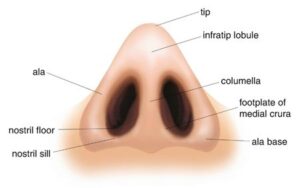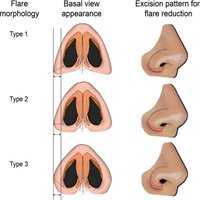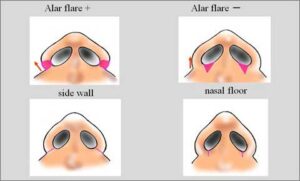

You have probably heard a lot about how poor posture affects your neck, back, and shoulders, but did you know that forward head tilt can also impact your nostrils and breathing?
While we often focus on the visual and skeletal implications of poor posture, the connection between neck posture and nasal airflow is seldom discussed.
In this article, I shall delve deep into how a forward head tilt posture can mess with your breathing, cause nasal issues, and even contribute to sleep problems.
Article Index:
- Introduction to Forward Head Tilt and Posture Issues
- Understanding the Structure of the Nostrils and Nasal Airways
- How Forward Head Tilt Changes Nasal Airflow
- Posture and Sinus Pressure: What’s the Connection?
- Daily Lifestyle Habits That Exacerbate the Problem
- Neck Pain and Breathing: How They’re Linked
- Scientific Evidence Supporting the Impact of Forward Head Tilt on Nostrils
- Conclusion: Does Forward Head Tilt Really Impact Your Nostrils?
Introduction to Forward Head Tilt and Posture Issues
Let’s be honest: how many times do you catch yourself hunched over your cellphone or slouched in front of your computer?
In today’s tech-heavy world, a forward head tilt posture is becoming all too common. It happens when the head juts forward in relation to the spine, causing the neck to compensate for the imbalance.
This posture can result in a forward leaning head that puts undue stress on the neck, shoulders, and even your nostrils—yes, your nostrils.
But how does your head position affect your breathing through your nose?
Well, it turns out that your posture and the angle of your neck play an integral role in how efficiently air moves through your nasal passages.
Understanding the Structure of the Nostrils and Nasal Airways
To understand how posture affects your nostrils, we first need to look at the structure of the nasal passages.
Your nostrils are the entry points to your respiratory system, filtering air as it flows through your nose into your lungs. When your head is properly aligned with your spine, this airflow is unrestricted.
However, when your head is tilted forward due to poor posture, the alignment of your airways changes, which can reduce the amount of air that passes through your nostrils.
This misalignment can also put pressure on the tissues and bones that support the nasal passages, potentially leading to restricted breathing, sinus issues, or even sleep apnea in some cases.
Think of it as a kink in a garden hose—when your posture is off, your nasal airflow becomes less efficient.
How Forward Head Tilt Changes Nasal Airflow
The impact of a forward neck tilt on your nostrils can be subtle but significant over time.
When you adopt a head tilted forward posture, the position of your neck changes, which alters the angle at which air enters your nostrils. This can cause a reduction in airflow, making it harder to breathe through your nose.
Over time, this can lead to feelings of nasal congestion, even if you don’t have a cold.
Ever notice that you breathe better when you sit up straight versus when you’re slouched over? That’s because poor posture can lead to nasal obstruction.
A study published in the Journal of Respiratory Care found that people with poor posture, including forward tilt posture, had increased nasal resistance, meaning it was harder for air to pass through their nasal passages.
Posture and Sinus Pressure: What’s the Connection?
Poor posture does not just affect airflow; it can also lead to increased sinus pressure.
When you adopt a forward leaning head posture, the position of your head can affect the drainage of your sinuses.
Normally, your sinuses drain naturally, but when your head is tilted forward, gravity works against this natural process, causing mucus to build up.
This can lead to sinus headaches, facial pressure, and even chronic sinus infections.
Think of it this way: your head weighs about 10-12 pounds. For every inch your head moves forward, it adds extra pounds of pressure on your neck and spine, and this pressure can extend to your sinus cavities.
If you have ever experienced neck pain when tilting head forward, you have probably also noticed a simultaneous feeling of nasal congestion or pressure in your face.
These two sensations are closely connected due to the structural relationships between the neck and the upper respiratory tract.
Daily Lifestyle Habits That Exacerbate the Problem
Let us now talk lifestyle.
Many of us unknowingly make our posture worse throughout the day.
Whether you are hunched over your laptop, constantly checking your phone, or even driving, these activities promote a forward leaning head posture.
These habits can aggravate both neck pain and nasal congestion, leading to a cycle of discomfort that’s tough to break.
Take the classic “text neck” example: You are looking down at your phone for hours at a time, which puts strain on your neck and pulls your head forward.
This can cause neck pain tilting head forward and reduce your nasal airflow, making it harder to breathe.
Over time, this posture leads to both neck discomfort and nasal issues, which can leave you feeling drained by the end of the day.
Neck Pain and Breathing: How They are Linked
We have all experienced neck pain when sliding your head in a forward position after a long day of bad posture, but did you know this neck pain can also affect your breathing?
When your neck is strained due to poor posture, it puts pressure on the muscles and tissues that support the airway, including the muscles surrounding your nostrils.
Imagine trying to breathe deeply while your neck is stiff and sore.
It is not easy, right?
That is because the muscles responsible for supporting your airways are overworked, making it harder to take in full breaths through your nose.
The pain you feel when you have neck pain tilting head forward is often accompanied by a reduction in your ability to breathe comfortably.
Scientific Evidence Supporting the Impact of Forward Head Tilt on Nostrils
The relationship between posture and nasal airflow isn’t just anecdotal—it is supported by scientific research.
A study published in the Journal of Craniofacial Surgery found that patients with poor posture, including forward head tilt posture, had significantly higher rates of nasal obstruction and sinus issues. This study confirms that your posture directly affects the efficiency of your nasal passages.
Another study in the European Respiratory Journal demonstrated that poor neck alignment can lead to increased nasal resistance, particularly in people with chronic sinus conditions.
The researchers found that correcting neck posture improved nasal airflow and reduced symptoms of sinus congestion, providing further evidence of the link between forward neck tilt and nasal health.
Does Forward Head Tilt Really Impact Your Nostrils?
So, does forward head tilt really impact your nostrils?
The answer is a definite “yes”!
Poor posture, particularly a forward head tilt posture, can restrict nasal airflow, increase sinus pressure, and contribute to neck pain that further exacerbates breathing difficulties.
When your head is tilted forward, the structural alignment of your nasal passages changes, making it harder to breathe through your nose.
We have discussed how daily habits, like hunching over your phone or slouching in front of your computer, can lead to both neck pain and nasal issues.
The connection between posture and breathing is supported by multiple scientific studies, including those published in the Journal of Craniofacial Surgery and the European Respiratory Journal.
The key takeaway?
While we often think of posture issues as affecting only the neck, shoulders, and back, your nostrils—and by extension, your overall respiratory health—are also directly impacted. Improving your posture by adopting the best forward head posture fix could be the first step to breathing easier.
References:


